
All by Carla Fernández (Mexican, b. 1973), Capa Julia. Made in collaboration with Fidel Martínez, Chimalhuacán, State of Mexico. Marina Collection, Spring–Summer 2022. Leather calado (fretwork) on wool. Funds from Textile and Fashion Circle, 2022.83. / Marina Calado Pants. Made in collaboration with Fidel Martínez, Chimalhuacán, State of Mexico. Marina Collection, Spring–Summer 2022. Leather calado (fretwork) on wool. Funds from Textile and Fashion Circle, 2022.77. / Yoreme Kaftan. Made in collaboration with Fidel Martínez, Chimalhuacán,
State of Mexico. 68 Spoken Languages Collection, Fall–Winter 2019–20. Leather calado (fretwork) on cotton with silver buttons. Funds from Textile and Fashion Circle, 2022.59A-B. © Carla Fernández
DENVER— February 7, 2023—In 2022, the Denver Art Museum (DAM) worked to broaden and deepen its collection through a number of significant acquisitions across its curatorial departments. This ongoing refinement and development of the museum’s holdings extends the DAM’s long-standing commitment to creating and maintaining a diverse collection that reflects the community and provides access and insight into cultures from around the world and through the centuries. Key 2022 acquisitions, including works by women and artists of color, encompass both purchases and gifts, and further enlarge the range of voices represented and the scope of stories the DAM can tell in its galleries. The museum also continued a tradition of adding works shown in exhibitions organized by the museum to the permanent collection.

Jeremy Frey (Passamaquoddy), Watchful Spirit, 2022. Ash tree fibers, porcupine quill, and sweet grass; 27 3/8 in. x 22 1/4 in. dia. Denver Art Museum: Purchased with the Nancy Blomberg Acquisitions Fund for Native American Art, 2022.51A-B © Jeremy Frey
Some highlights of the past year’s acquisitions include:
- Eleven looks by contemporary fashion designer Carla Fernández, created in collaboration with Mexican and Mexican Indigenous artisans (from the exhibition Carla Fernández Casa de Moda: A Mexican Fashion Manifesto)
- Vicente Telles’ painting La Malinche (from the exhibition Traitor, Survivor, Icon: The Legacy of La Malinche)
- Three paintings by Lim Ok-Sang, a contemporary artist at the heart of the Minjung (People’s Art) movement
- Hulda Guzmán’s 2022 piece, Jusqu’ici tout va bien (So far, so good), an important addition to the museum’s recently established Latin American Contemporary Art collection
- Three works by Matthew Brannon—a mixed-media sculpture; letterset and offset on paper, glass; and a wood and metal enamel piece
- Seven watercolor and ink on paper works by Chiura Obata, one of the most significant Japanese American artists working on the West Coast during the last century
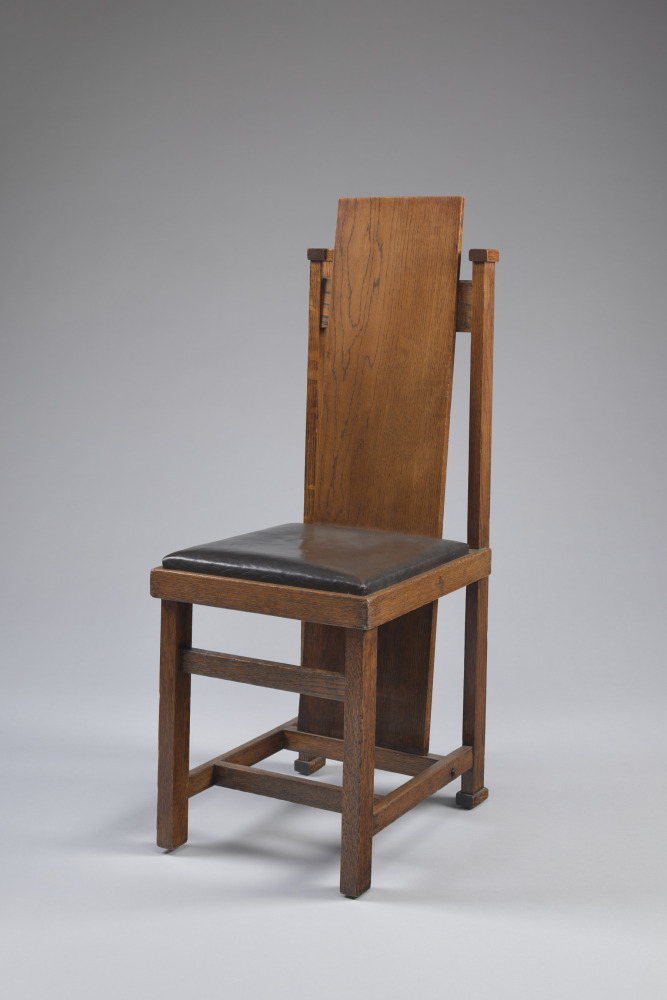
Frank Lloyd Wright, Side Chair, 1904. Oak and leather upholstery; 40 1/4 x 13 3/4 x 18 3/4. Denver Art Museum: Gift of Daniel Wolf, 2022.136.
Architecture and Design
The department of Architecture and Design acquired 28 works by 21 different artists, including pieces by Zaha Hadid, Samuel Ross, and a slant-back side chair designed by Frank Lloyd Wright—an adaptation of what would become one of Wright’s most notable furniture designs. Formerly a long-term loan, this chair gifted to the DAM by collector Daniel Wolf is one of the most significant objects in the Architecture and Design collection. This masterpiece, along with two other noteworthy works, was gifted to the museum after Daniel Wolf’s passing in January 2021.
Other works entering the collection included furniture, flatware, posters and other pieces such as Desert Paper 09, the result of a collaboration between New York- and Tucson-based design firm Aranda\Lasch and acclaimed Tohono O’odham weaver and activist Terrol Dew Johnson
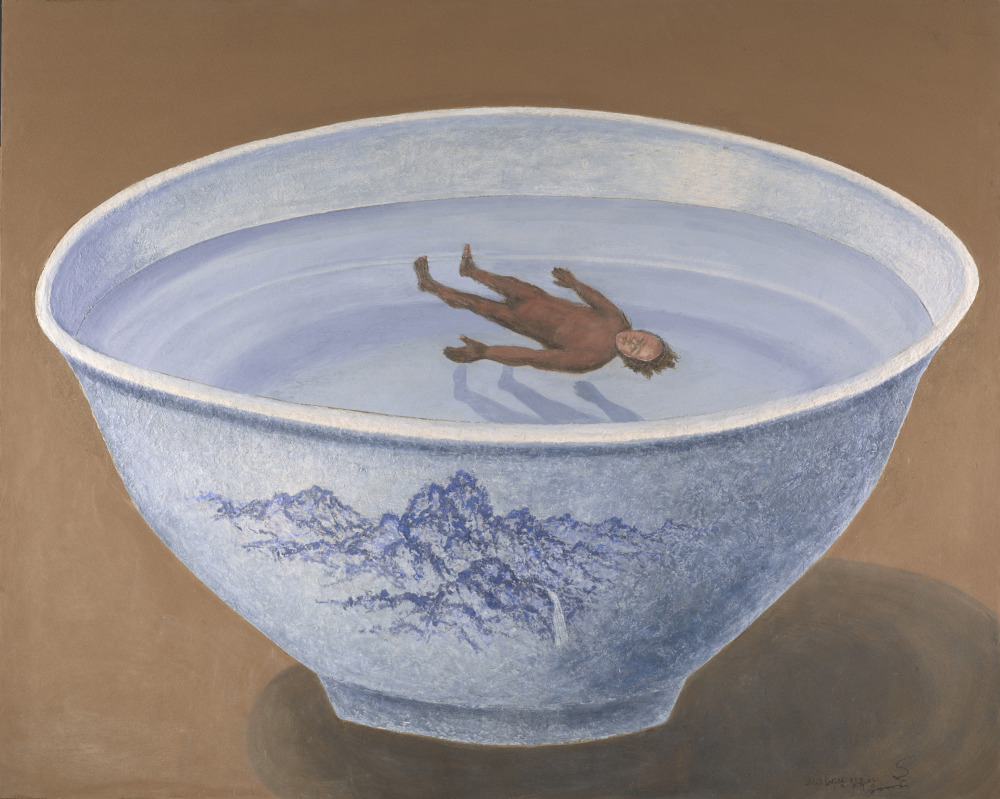
Ok-Sang Lim 임옥상, Not a Bowl II 불기 (不器) II, 2021. Mixed media on canvas; 71.5 x 107.25 in. Denver Art Museum: Gift of Gana Art Foundation, 2022.126. © Ok-Sang Lim 임옥상
Arts of Asia
With the exception of a late 1800s Scholar’s Desk from Korea, gifted in honor of the appointment of Hyonjeong Kim Han as head of the Arts of Asia department, each of the works added to the collection were created in the last hundred years.
Three of the acquisitions are works by Lim Ok-Sang, a South Korean artist at the center of the Minjung (People’s Art) movement, a name coined during the Gwangju Democratic Uprising in 1980. In one of the newly acquired works, Not a Bowl II, the artist incorporates clay—a medium traditionally used in making ceramics—on his 2021 canvas. In the last decade, Lim has created paintings depicting the desire to dwell in peaceful nature, nature’s relationship with human beings and embracing freedom.
An additional contemporary Asian art acquisition is 2016-9-30 by Fong Chung-ray, an artist born in China, active previously in Taiwan, and currently living in the Bay Area. Fong is one of the major figures in the Fifth Moon Group, the Taiwanese ink art movement.
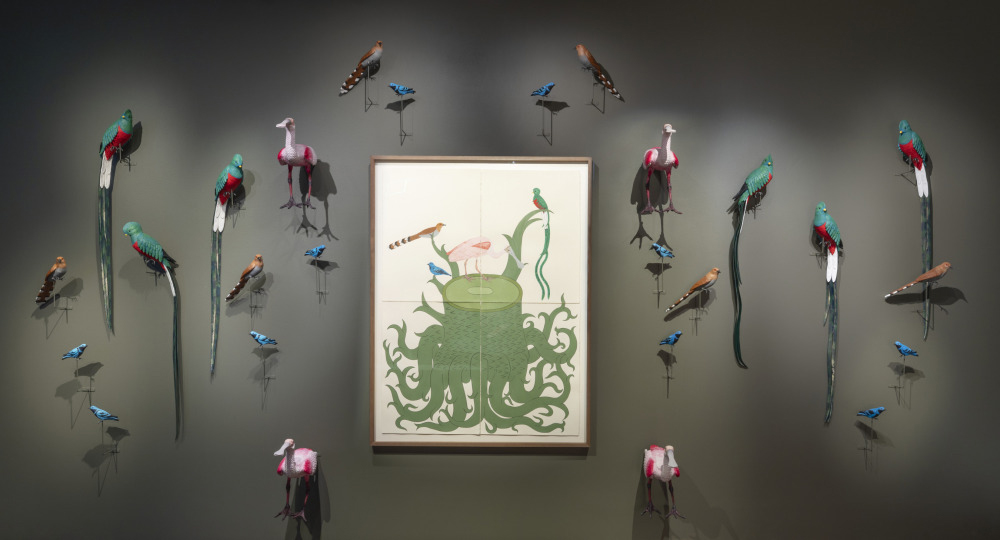
Eduardo Sarabia, Ceiba Sagrada, (featuring the Roseate Spoonbill, Lovely Continga, Quetzal, and the Squirrel Cuckoo) 2016. Acrylic paint, India ink, and set of 26 red clay, white ceramic, fiber glass, and cast metal birds; overall: 25. 19 x 66.14 in. Funds from Baryn, Daniel, and Jonathan Futa. © Eduardo Sarabia
Arts of the Ancient Americas
The Arts of the Ancient Americas department made three additions to the collection, including a goblet that represents an outstanding example of Cholula-style ceramics crafted by an unknown Mixtec artist. Drinking vessels like this small goblet were designed for the consumption of chocolate or pulque, a fermented alcoholic beverage.
Two additional pieces were joint acquisitions with the Latin American Art department—one each from the recent exhibitions ReVisión: Art of the Americas and Traitor, Survivor, Icon: The Legacy of La Malinche.
Eduardo Sarabia’s Ceiba Sagrada (featuring the Roseate Spoonbill, Lovely Continga, Quetzal, and the Squirrel Cuckoo), originally on view as part of ReVisión, features a framed image of a cross-cut green ceiba tree surrounded by more than two dozen vibrantly colored, cast-metal birds. Sarabia represents four distinct species—cuckoo, roseate spoonbill, cotinga and quetzal—each of which contributed feathers to the elaborate headdress associated with Moctezuma, the ruler of the Aztec empire.
In a shimmering painting on copper ground, artist Vicente Telles depicts La Malinche, a young Nahua girl who played a pivotal role during the Conquest of Mexico, or the Spanish and Aztec war. The composition of this work recalls traditional representations of the Virgin of Guadalupe. A key addition to the museum’s Southwest Santos collection, it references the important cultural history of mestizo (mixed-race) people in New Mexico and Colorado through the story of the historical figure of La Malinche.
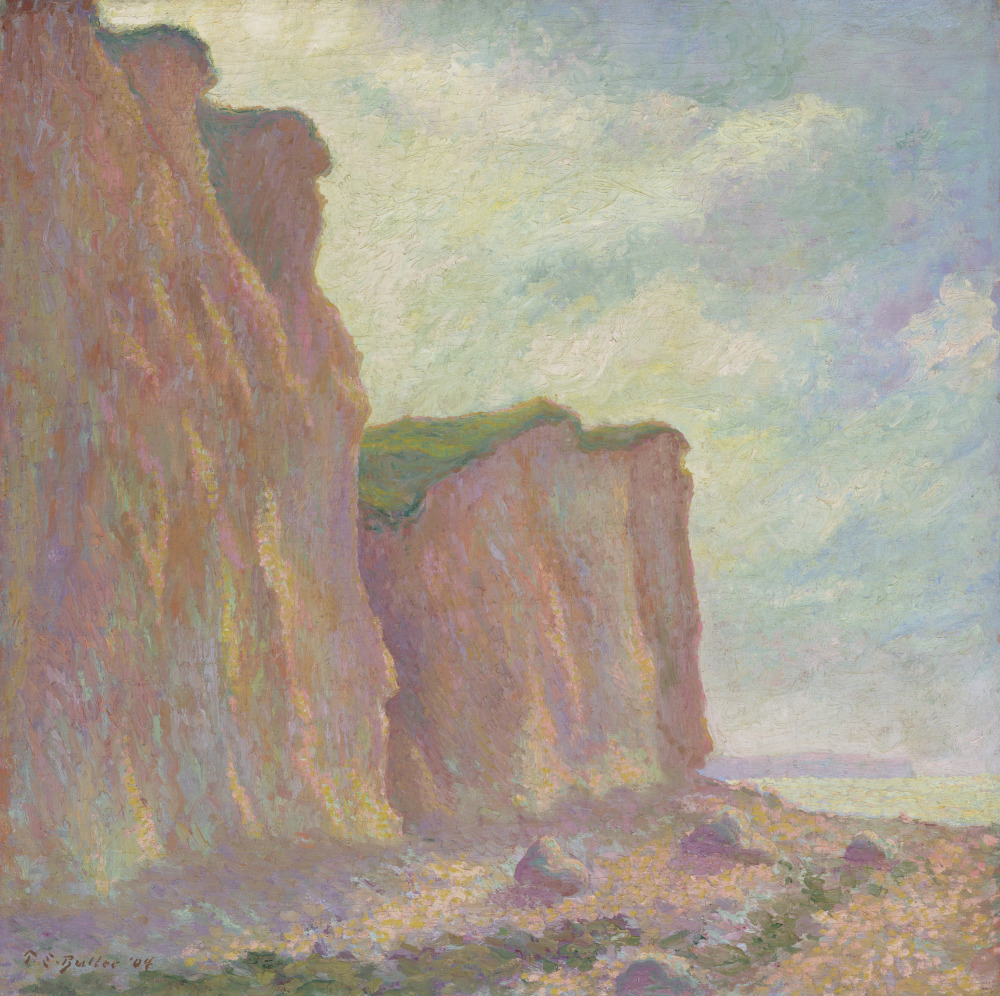
Theodore Earl Butler, Cliffs, 1904. Oil paint on canvas. Gift of Thomas and Veronique Foster, 2022.141.
European and American Art
The department of European and American Art before 1900 added seven paintings to the collection, ranging from the 16th century Portrait of a Man by a Netherlandish artist to a 1904 work by Monet’s son-in-law, Theodore Earl Butler.
The distinctive white chalk cliffs that Butler painted in 1904 while sojourning in Quiberville on the Normandy coast demonstrate the artist’s fascination with colors and brushstrokes, clearly influenced—in both technique and subject matter—by his father-in-law, Claude Monet. In addition to works inspired by the Impressionist movement, Butler experimented with other emerging styles, including neo-impressionism and fauvism.
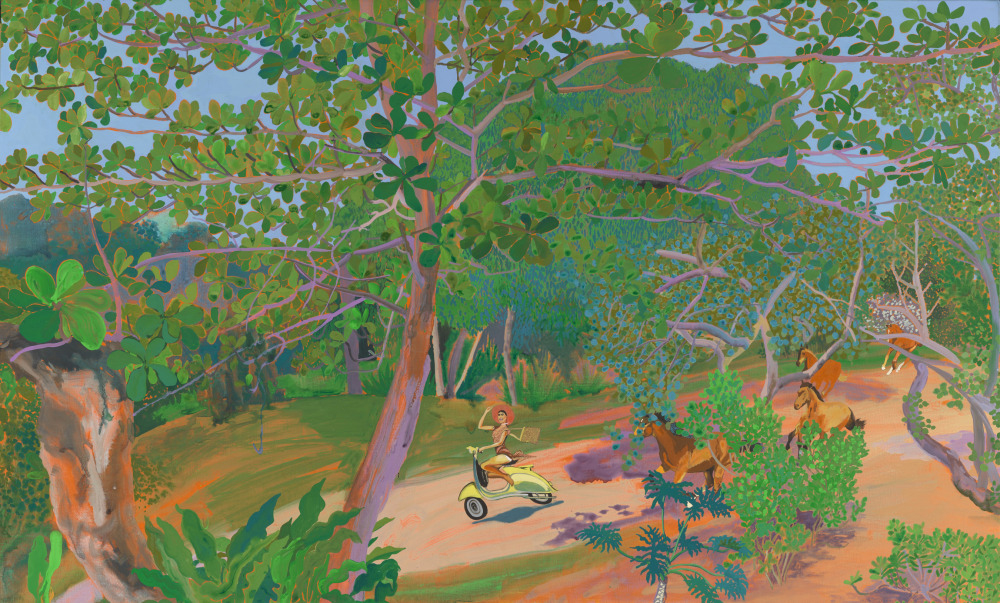
Hulda Guzmán, Jusqu’ici tout va bien (So far, so good), 2022. Acrylic gouache paint on linen; 30⅛ × 49⅝ in. Funds from the Contemporary Collectors’ Circle with additional support from Craig Ponzio; John & Sandy Fox; A. Barry & Arlene Hirschfeld; Baryn, Daniel, and Jonathan Futa; Bryon Adinoff & Trish Holland; Ellen & Morris Susman; and Margaret & Glen Wood, 2022.124. © Hulda Guzmán Conde
Latin American Art
The 17 acquisitions made by the department this past fiscal year included five artworks by women artists, the bequest of a lacquer Maque chest (arqueta) from the 1770s and the gift of seven color woodcut prints. These works add to the museum’s newly created but rapidly expanding Latin American Contemporary Art collection. The department is committed to challenging preconceptions about the boundaries of Latin America through the inclusion of Caribbean artists and to expanding the representation of women artists in the permanent collection.
A key acquisition for the department is a painting by Dominican artist Hulda Guzmán, who explores how her painting practice can relate to landscape, animal life and fiction. In Jusqu’ici tout va bien (So far, so good), a cartoonish female figure that resembles the artist grabs her sun hat to keep the wind from blowing it off as she gazes directly at the audience, drawing us into her world. Guzmán is one of 19 artists featured in Who tells a tale adds a tail: Latin America and contemporary art, on view through March 5, 2023.
Arthur Timótheo da Costa’s painting Portrait of a Boy is the first Brazilian artwork from the early 1900s to enter the DAM’s collection. Born in 1882 to a family of African descent in Rio de Janeiro, Brazil, da Costa began his art studies at a young age at the Casa da Moeda do Brasil (Brazilian Mint), where he studied drawing and engraving. Overcoming the widespread race and class prejudices and limitations of that time, da Costa had a remarkable artistic career, exhibiting his works regularly until the early 1920s, when his mental health rapidly declined.
In 2022, the museum’s annual Collectors’ Choice event raised nearly $800,000, and the net proceeds will support future acquisitions of modern and contemporary Latin American art.
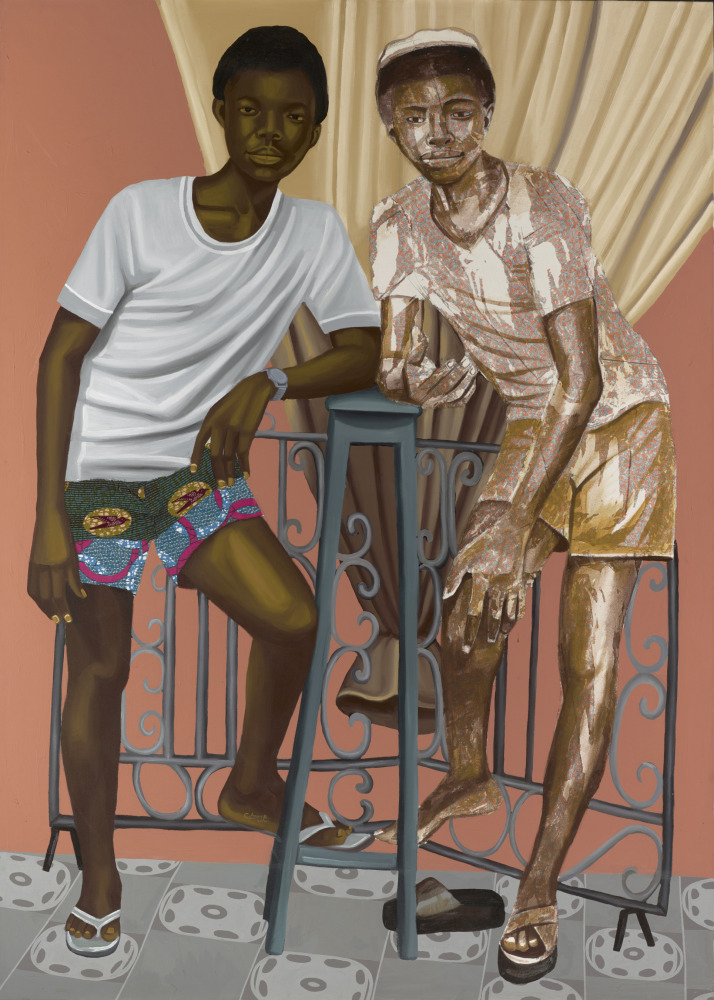
Cornelius Annor (Ghana), Aboki, 2022. Fabric collage, fabric transfer, and acrylic on canvas, 83 ¾ x 59 ¾ x 1 ½ inches. Denver Art Museum: Gift of Federico Martin Castro Debernardi, 2022.55. © Cornelius Annor
The Modern and Contemporary Art department added 16 works to its collection this past year, including two acrylic paintings by Barbara Rossi and three artworks by Ghanian and Ghanian-American artists, among them Cornelius Annor.
Working with personal memories and family history, Annor draws upon his archive of family photographs and fabrics sourced from his wife, mother and aunts to create intimate portraits of everyday life in his native Ghana. Based on a 1967 photograph of two friends, Aboki depicts Mr. Nkansah, in white T-shirt and patterned shorts, and Mr. Ofori, who has since died. Suffusing Mr. Ofori’s body and clothing with rust-colored hues, Annor recalls the sepia tones of antique photographs and the passage of time.
New York-based artist Matthew Brannon explores the anxieties and concerns of contemporary society through imaginatively structured collisions of image and text. Influenced by graphic design and promotional advertising, Brannon’s figures and shapes are seemingly understated, yet their familiar visual appeal is at odds with the shifts in meaning he introduces through disjunctive language and realignments of context. Nuanced and layered, Brannon’s work reveals society’s ills or, as the artist puts it, “personal pathologies.”
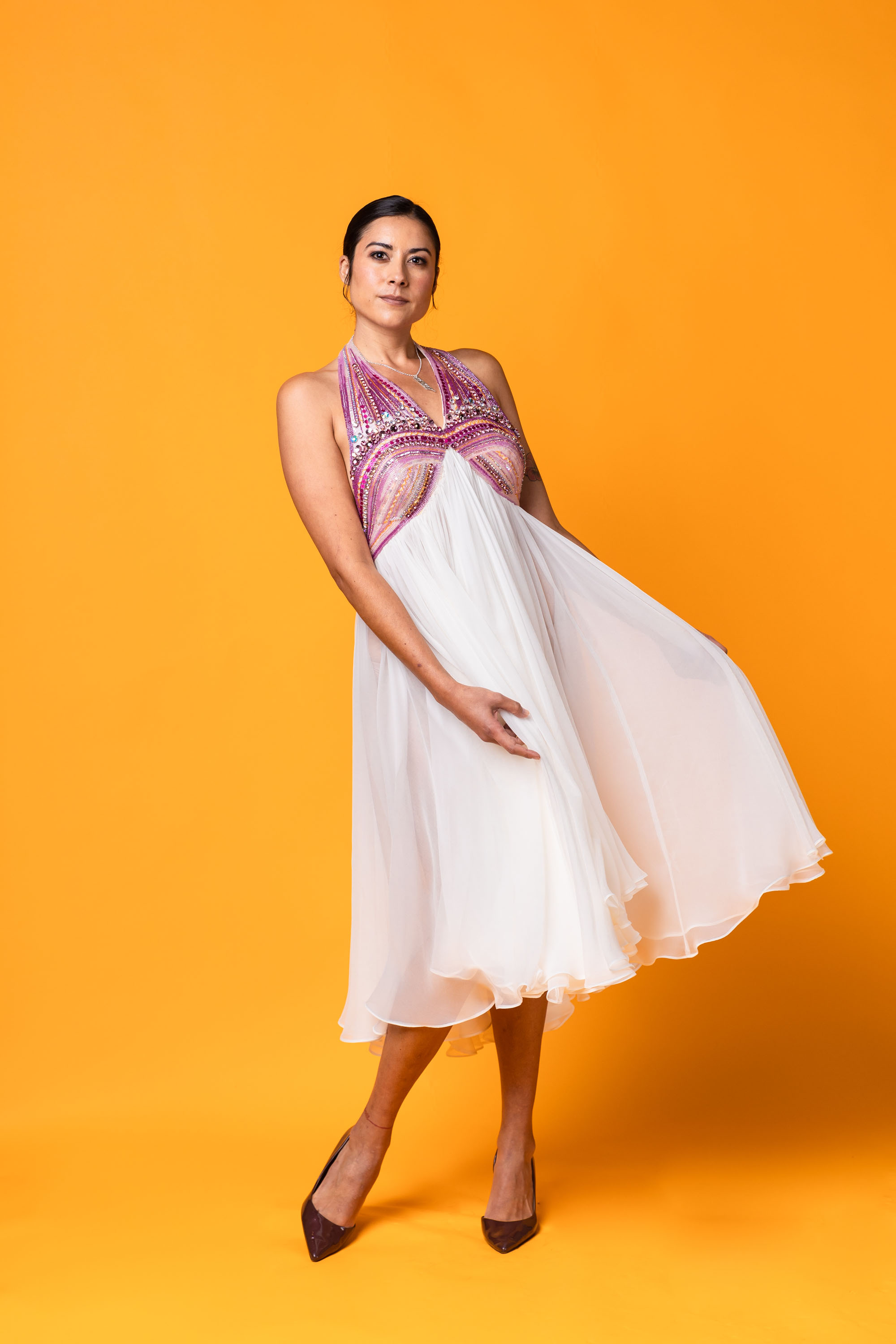
Orlando Dugi (Diné), The Eye Dazzler, 2021. Tambour beading and metal
embroidery on nylon tulle with glass beads, crystals, metal flat threads, silk
chiffon, silk habitat; 49 × 16 in. Denver Art Museum: Gift of The People's Art
Fund on behalf of Dylan Jacobs and Kaye Wilson. ©Orlando Dugi. Modeled by
Darrah Blackwater. Photography by Tira Howard and courtesy of SWAIA Fashion.
Native Arts
The Native Arts department, which encompasses the collections of Arts of Africa, Arts of Oceania and Indigenous Arts of North America, acquired seven works by Indigenous artists from North America, 11 works by artists from Morocco and six works by artists from Micronesia.
Santa Fe-based fashion designer Orlando Dugi (Diné aka Navajo) creates extravagant, contemporary fashion pieces, which draw inspiration from Diné philosophies of beauty. His dress, The Eye Dazzler, is informed by 19th century Diné textiles called Germantown Eye Dazzlers, so named because their closely interwoven colors and patterns give the appearance of visual vibration. This dizzying effect is mimicked in the dress by the sparkling bodice and 20+ yards of flowing silk chiffon, all intended to dazzle and shift with the movement of the wearer.
Jeremy Frey (Passamaquoddy), a Wabanaki artist based in Maine, is among the premier basket weavers in America. In 2018, former curator Nancy Blomberg commissioned Frey to create his “ultimate masterpiece.” Pictured on page 1, the basket—titled Watchful Spirit—is one of the largest Frey has ever made. Besides the absolute perfection in weaving technique, the most stunning attribute of this work is the quilled lid. The artist used only the natural color variations found in porcupine quills to create the mountain lion in intricate detail.
The art of weaving baskets, mats and jewelry is highly developed in the Marshall Islands, and Marshallese women are noted as some of the most skilled weavers in the Pacific Islands. In 2022 the DAM acquired a Kili bag in advance of the May 2023 reopening of the Arts of Oceania galleries. These distinctive white bags, woven from the finest coconut fiber, were first created by women from Bikini Atoll who were relocated in the 1940s to Kili Island by the U.S. government because of the US Nuclear Testing Program. The 1954 test of the largest nuclear device the U.S. ever detonated, Castle Bravo Bomb, was exploded off the coast of Bikini Atoll, resulting in contamination of the atoll that rendered it uninhabitable. First Lady Jacqueline Kennedy was gifted a Kili bag and helped popularize the bags by carrying it.
Other significant acquisitions included works by Frank Big Bear (Ojibwe), Sidney Whiting, Jr. (Sičháŋǧu Lakȟóta), Marianne Nicolson (‘Tayagila’ogwa) (Kwakwaka'wakw), Stephen Mopope (Kiowa), 11 metal works by Moroccan artists and five other works of jewelry and weaving by Micronesian artists.
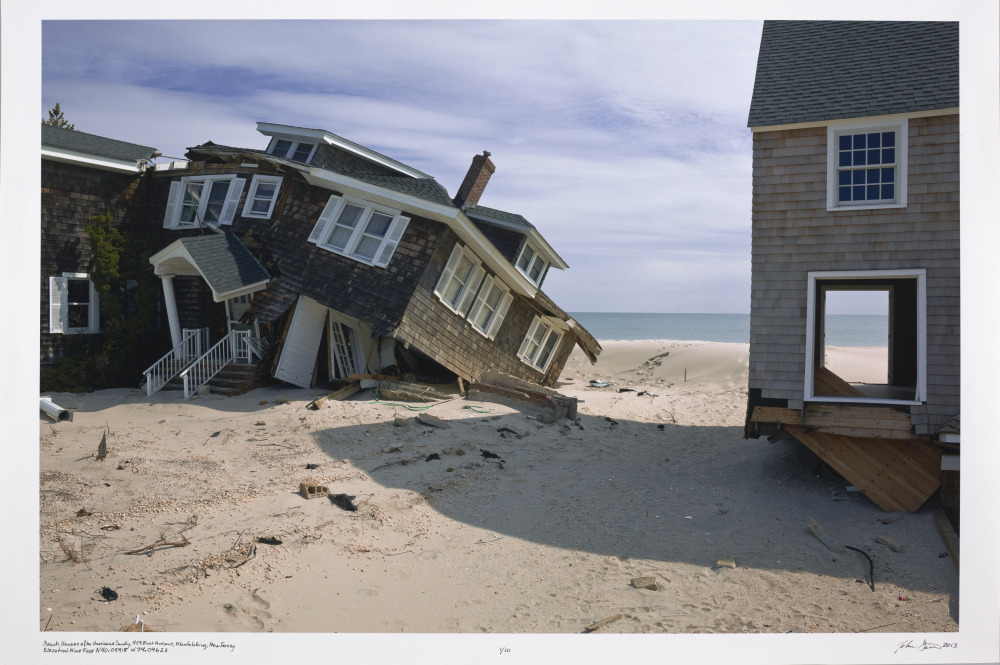
John Ganis, Beach Houses After Hurricane Sandy, 959 East Avenue, Mantoloking, New Jersey, from the series America’s Endangered Coasts, March 2013. Inkjet print; 22 × 33 in. Funds from Larry Rothman, 2022.5. © John Ganis
Photography
The Photography department added 193 new works to the collection through both gifts and purchases, with a strong representation of women photographers (127 pieces) as well as 10 works by artists of color. In addition to the highlights below, photos by such noted artists as Arthur Wesley Dow, Richard Benson, Andrea Modica, W. Eugene Smith, Yolanda Andrade, Mariana Yampolsky and the Sweet Medicine portfolio of 30 photos by Drex Brooks also were acquired.
In his series America’s Endangered Coasts, John Ganis photographed human-created landscapes likely to be erased by the effects of climate change. In Beach Houses After Hurricane Sandy, 959 East Avenue, Mantoloking, New Jersey, a crumpled, shingle-style beach house is on the left, while the house on the right hovers thirty inches in the air—the beach and the house’s foundation washed away in the storm surge from Hurricane Sandy. In the background, the vast, unpredictable ocean stretches to the horizon.
With sharp intuition and quick reflexes, Lola Álvarez Bravo described the everyday lives of ordinary Mexicans with fluidity and grace. Her photograph Mar de ternura (Sea of Tenderness), from about 1945, is a gentle and evocative example of her approach.
Zora J. Murff’s series At No Point In Between focuses on people and places in the historically Black neighborhood of North Omaha, Nebraska, where the artist grew up. His photographs suggest informal conversations that give presence to both the photographer and his subjects as they negotiate life in a place that has been shaped by acts of racial violence and continues to suffer from the effects of redlining and economic suppression. As Murff puts it, the pictures in At No Point In Between “…metaphorically connect the body and the landscape, fast and slow violence.”

Carla Fernández (Mexican, b. 1973), Ave Poncho and Pants. Made in collabora-tion with Gilberto Nuci and Feliciana Hernández, Ahuiran, Michoacán. Ropa de Trabajo (Work Clothes) Collection, Fall–Winter 2022. Rapacejo (complex knotting) on linen and rapacejo on viscose. Funds from the Textile and Fashion Circle, 2022.89 and 2022.95. © Carla Fernández
Avenir Institute of Textile Arts and Fashion
Of the Avenir Institute’s 60 acquisitions during the past year, 42 pieces were by contemporary female fashion designer Carla Fernández. The 11 ensembles acquired were created in collaboration with Mexico City based artists and Mexican Indigenous artisans from the communities of Ahuiran, Michoacán; Ihuatzio, Michoacán; San Pablito, Puebla; Chimalhuacán, State of Mexico; Tenancingo, State of Mexico; Santa María Rayón, State of Mexico; San Juan Chamula, Chiapas; and Oaxaca, many of whom also are women.
Acquired with funds from the Textile and Fashion Circle, the 11 ensembles are representative of each section of the DAM’s retrospective, Carla Fernández Casa de Moda: A Mexican Fashion Manifesto (May 1–October 16, 2022). One to three looks were chosen from each section to illustrate the overarching themes of Fernández’s fashion manifesto including slogans such as “The Origin of Textile is the Earth” and “Fashion as Resistance.” This is the DAM’s first major acquisition from a contemporary Latin American fashion designer and widens the scope of the permanent fashion collection.
Additionally, a cocktail dress by American designer JamesGalanos and pair of pantaloons by French designer Paul Poiret were gifted to the collection.

Chiura Obata (American, b. Japan, 1885–1975), Jemez Spring, 1949. Watercolor on paper. Gift of the Estate of Chiura Obata, 2022.118. ©Estate of Chiura Obata
Western American Art/Petrie Institute
The Petrie Institute of Western American Art at the DAM added 12 works to the collection, including an outstanding nocturne by Frank Tenney Johnson, the first work to enter the collection by Alexandre Hogue, and seven pieces by Chiura Obata, one of the most significant Japanese American artists working on the West Coast during the last century.
Obata emigrated to the United States from Japan in 1903. His nearly two-decades-long tenure as a professor at UC Berkeley (1932-1954) was interrupted during World War II from 1942 to 1945. He and his family were forced to move first to the relocation center in Tanforan, CA, and then to the incarceration camp at Topaz, UT. While at these camps, Obata helped found a number of art schools.
Obata engaged with a wide array of traditions and techniques during his long career. As a result, his work often defies strict cultural categorization. The acquisition of these seven ink and watercolor artworks reinforces the Petrie Institute’s mission to reveal the complexity of the cultural and artistic interchange intrinsic to the region we call the American West.
About the Denver Art Museum
The Denver Art Museum is an educational, nonprofit resource that sparks creative thinking and expression through transformative experiences with art. Its mission is to enrich lives by sparking creative thinking and expression. Its holdings reflect the city and region—and provide invaluable ways for the community to learn about cultures from around the world. Metro residents support the Scientific and Cultural Facilities District (SCFD), a unique funding source serving hundreds of metro Denver arts, culture and scientific organizations. For museum information, visit www.denverartmuseum.org or call 720-865-5000.
Media Resources
- Online Newsroom: www.denverartmuseum.org/press
- Facebook: www.facebook.com/denverartmuseum
- Twitter: www.twitter.com/denverartmuseum
- Instagram: www.instagram.com/denverartmuseum
Media Contact
Andy Sinclair, Media Relations Manager
Denver Art Museum
720-913-0096
asinclair@denverartmuseum.org
pressoffice@denverartmuseum.org
